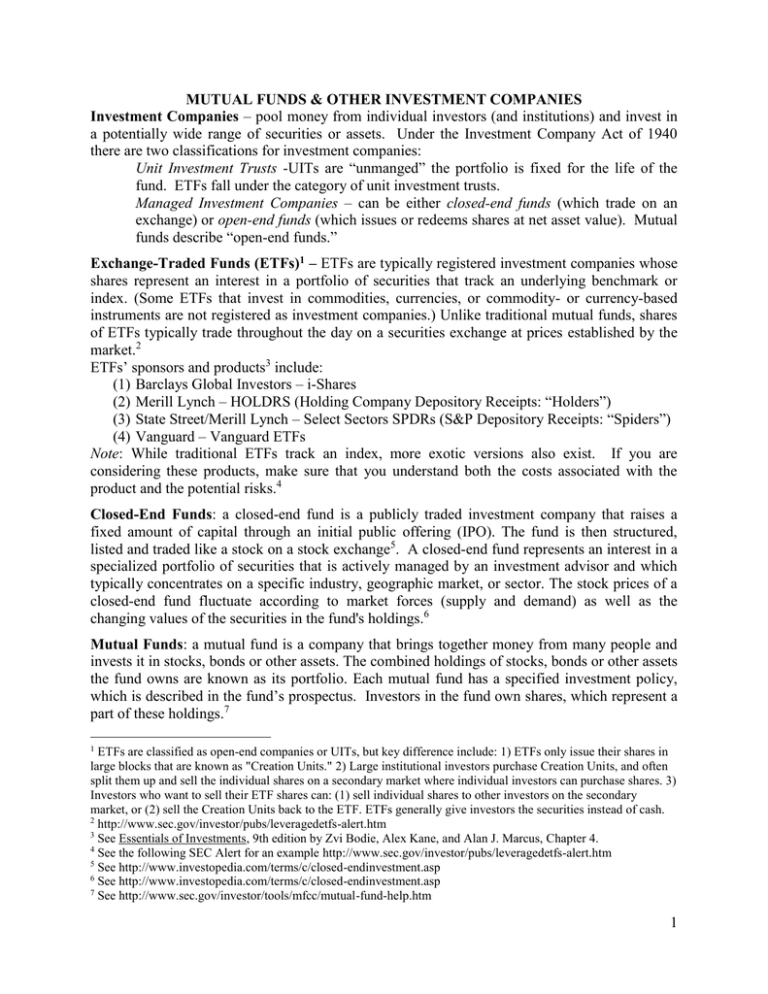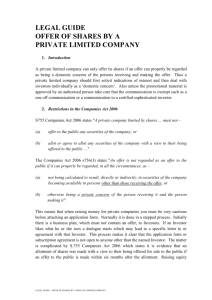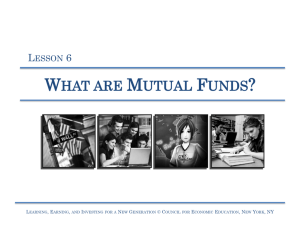Mutual Funds & Other Investment Companies
advertisement

MUTUAL FUNDS & OTHER INVESTMENT COMPANIES Investment Companies – pool money from individual investors (and institutions) and invest in a potentially wide range of securities or assets. Under the Investment Company Act of 1940 there are two classifications for investment companies: Unit Investment Trusts -UITs are “unmanged” the portfolio is fixed for the life of the fund. ETFs fall under the category of unit investment trusts. Managed Investment Companies – can be either closed-end funds (which trade on an exchange) or open-end funds (which issues or redeems shares at net asset value). Mutual funds describe “open-end funds.” Exchange-Traded Funds (ETFs)1 – ETFs are typically registered investment companies whose shares represent an interest in a portfolio of securities that track an underlying benchmark or index. (Some ETFs that invest in commodities, currencies, or commodity- or currency-based instruments are not registered as investment companies.) Unlike traditional mutual funds, shares of ETFs typically trade throughout the day on a securities exchange at prices established by the market.2 ETFs’ sponsors and products3 include: (1) Barclays Global Investors – i-Shares (2) Merill Lynch – HOLDRS (Holding Company Depository Receipts: “Holders”) (3) State Street/Merill Lynch – Select Sectors SPDRs (S&P Depository Receipts: “Spiders”) (4) Vanguard – Vanguard ETFs Note: While traditional ETFs track an index, more exotic versions also exist. If you are considering these products, make sure that you understand both the costs associated with the product and the potential risks.4 Closed-End Funds: a closed-end fund is a publicly traded investment company that raises a fixed amount of capital through an initial public offering (IPO). The fund is then structured, listed and traded like a stock on a stock exchange5. A closed-end fund represents an interest in a specialized portfolio of securities that is actively managed by an investment advisor and which typically concentrates on a specific industry, geographic market, or sector. The stock prices of a closed-end fund fluctuate according to market forces (supply and demand) as well as the changing values of the securities in the fund's holdings.6 Mutual Funds: a mutual fund is a company that brings together money from many people and invests it in stocks, bonds or other assets. The combined holdings of stocks, bonds or other assets the fund owns are known as its portfolio. Each mutual fund has a specified investment policy, which is described in the fund’s prospectus. Investors in the fund own shares, which represent a part of these holdings.7 1 ETFs are classified as open-end companies or UITs, but key difference include: 1) ETFs only issue their shares in large blocks that are known as "Creation Units." 2) Large institutional investors purchase Creation Units, and often split them up and sell the individual shares on a secondary market where individual investors can purchase shares. 3) Investors who want to sell their ETF shares can: (1) sell individual shares to other investors on the secondary market, or (2) sell the Creation Units back to the ETF. ETFs generally give investors the securities instead of cash. 2 http://www.sec.gov/investor/pubs/leveragedetfs-alert.htm 3 See Essentials of Investments, 9th edition by Zvi Bodie, Alex Kane, and Alan J. Marcus, Chapter 4. 4 See the following SEC Alert for an example http://www.sec.gov/investor/pubs/leveragedetfs-alert.htm 5 See http://www.investopedia.com/terms/c/closed-endinvestment.asp 6 See http://www.investopedia.com/terms/c/closed-endinvestment.asp 7 See http://www.sec.gov/investor/tools/mfcc/mutual-fund-help.htm 1 Net Asset Value (NAV) – represents assets minus liabilities on a per-share basis. Mutual funds trade once daily based on NAV, while closed-end fund prices may differ from the fund’s NAV. Net Asset Value Assetsmarket value Liabilitiesmarket value Shares outstanding Example8 Suppose a mutual fund manages a portfolio of securities worth $120M and the fudn owes $4M to its investment advisors and $1M for rent, wages, and misc expenses. If the fund has 5M shares outstanding then NAV = $23/share. NAV $120million $4million $1million $23 5million Investing in Mutual Funds (Costs & Share Class) The costs of investing in mutual funds can be somewhat opaque to the average investor (I am glad you are reading this note) since they are deducted from the assets of the fund.9 Many mutual fund offer different share classes: Class A Shares – typically have front-end loads and a small 12-b-1 fee. Class B Shares – rely on larger 12b-1 fees and a back-end load, if the investor holds these shares for a predetermined length of time (typically 6-8 years) they convert to Class A. Class C Shares – generally rely on 12b-1 fees and back-end loads, but these shares usually do not convert to Class A. Operating expenses: include administrative expenses and advisory fees paid to the management. These may range from 0.2% to 2%. Loads: represent a sales charge that an investor must pay to purchase certain classes of mutual fund shares. Front-end loads are charged when a fund is purchased and are essentially sales charges to pay the broker for selling the fund. Back-end loads are charged when an investor sells certain types of shares. Some funds use back-end loads to discourage investors from switching funds too often. Back-end loads are often given a sliding scale, which means that the longer you hold the shares, the smaller the back-end load. No-load funds do not charge a commission when funds are purchased or sold. 12b-1 fees: can range from 0.25% to a legal maximum of 1%, these fees are used by managers to pay for distribution costs such as advertising, promotional literature including annual reports and prospectus, and commissions. Soft dollars: portfolio managers will direct some of the fund’s trades to a broker in exchange for research services. Rather than paying for these services directly, the fund incurs trading commissions that are not reflected in reported expense ratios.10 Graduate Assistant Kaoutar Houmairy, Babson College contributed to the completion of this class note. 8 See Essentials of Investments, 9th edition by Zvi Bodie, Alex Kane, and Alan J. Marcus, Chapter 4. Investors can obtain the expense ratio for a fund from the Morningstar database, additional details are provided in the company’s prospectus. 10 See http://www.investopedia.com/ask/answers/04/011404.asp Potential additional "hidden" costs and liabilities such as tracking error, poor underlying liquidity or credit risk. http://stonehedge-partners.com/capital/ 9 2







